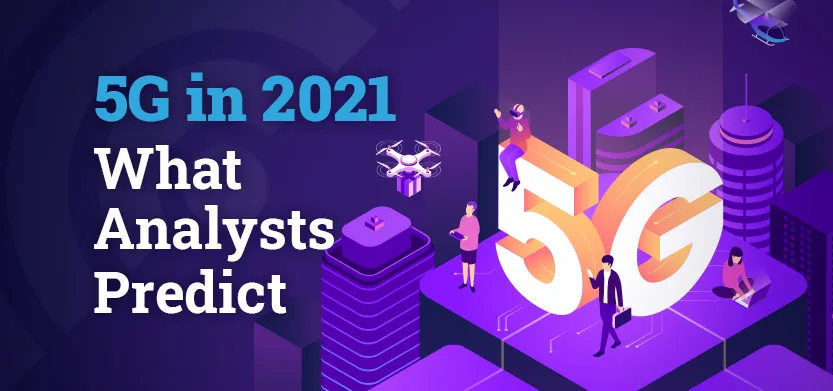
Posted in Consulting
October 29, 2020
5G in the future: What analysts predict
With 5G coverage expected to reach as high as 75% in 2021, it would seem that the 5th generation of wireless and communications technology is ready to launch in a big way. Increased speeds, improved reliability and lower latency all promise a revolution in the way telecommunications companies deliver superior products and services to the world. But, numbers are not always what they seem. Coverage inconsistency and lower numbers of 5G enabled devices could make the coming years tough for telecom providers hoping to cash in on 5G investments.
Predictions for 5G telecommunications providers
- Balancing 5G infrastructure builds against revenue constraints — Managing the economics of building infrastructure against declining revenue.
- Time is of the essence for 5G network builds — To be able to provide 5G service to the estimated 1.4 billion 5G enabled devices that will come online, telecoms will need to prioritize 5G builds.
- Small cell sites and deep fibre deployment are immediate concerns — 5G networks will require more small cell tower sites and fibre optic deployment to achieve the promised coverages and speeds.
- Better network, better support — Telecommunication companies will need to look at is how their internal operations and processes are developed to handle the new consumer experience that is expected to go along with the 5G offerings.
Balancing 5G infrastructure builds against revenue constraints
While the telecommunications industry saw early adoption and return on investments for 3G and 4G technology, all signs point to a slower, more steady ramp-up to 5G consumer adoption, and therefore, slower to realize increases in revenue for communications providers. This can lead to an economic balancing act for telcos that are responsible for building and maintaining this new infrastructure.
All is not lost though. PricewaterhouseCoopers notes that while device penetration has stalled at 4% for 5G enabled devices, it expects that the market will hit the proverbial tipping point in 2023, where 5G devices, including mobile phones, virtual and augmented reality devices and connected Internet of Things (IoT) applications like smart home appliances, will make up the bulk of the devices that make up traffic on the 5G network. PwC is not alone in this assessment, with other analysts forecasting a longer ramp-up to consumer adoption:
“Morgan Stanley estimates that the industry will spend $225 billion on 5G between 2019 and 2025, with the biggest outlays coming later. The first 5G enabled smartphones could come to market as early as 2020, but the real pick-up in spending will take years, even decades” - 5G Wireless Challenges and Predictions, Morgan Stanley.
Time is of the essence for 5G network builds
What that means for telecoms is that while they do have some breathing room to fund infrastructure upgrades, they have a little under 2 years to get the network infrastructure in place to run the approximate 1.4 billion 5G enabled mobile devices expected to be online by 2023. That’s just mobile. Add to that the other devices such as autonomous vehicles, environmental sensors, thermostats, security cameras, and the potential list goes on and on. We are beginning to see these devices come out on the consumer end, but what it means for industry and healthcare is also astonishing. All the more reason why Telcos that want to be at the top of the game need to prioritize infrastructure developments in 2021.
Small cell sites and deep fibre deployment are immediate concerns
Deployment of deep fibre networks and more small cell sites is going to be of major focus for the coming years, building the infrastructure needed to get and keep 5G services up to speed, delivering consistent quality and expanding coverage.
“A Deloitte Consulting LLP analysis estimates that the United States requires between $130 and $150 billion over the next 5–7 years to adequately support broadband competition, rural coverage and wireless densification.” - Communications Infrastructure Upgrade: The Need for Deep Fiber
5G technology operates at a higher frequency than that of the current 3G/4G/LTE networks. These higher frequency signals cannot travel as far as lower frequency transmissions, making them more susceptible to interference. The solution to this interference, which would result in a lack of coverage or lower transmission speeds, is to dramatically increase the number of cell sites across the coverage area. In addition to the new cell sites, the deployment of deep fibre (in most cases, fibre optic cable installed closer to the end-user) is a critical, and labour/cost-intensive part of the network infrastructure upgrades that communication service providers need to make. This deep fibre deployment is necessary to facilitate the high-speed transmission of data across the network and without the fibre outlay, the efficiency and coverage of 5G will not be consistent or complete.
Better network, better support
With the new infrastructure in place and 5G enabled devices on the rise, the next big thing that Telecommunication companies will need to look at is how their internal operations and processes are developed to handle the new consumer experience that is expected to go along with the 5G offerings. Not only will customers expect faster speeds from the 5th gen technology, but they are going to expect cleaner, more intuitive experiences when dealing with the providers of 5G services.
“Current telco operating models are designed to maintain a 4G network not fit for 5G. To evolve, telcos will need to overhaul everything from infrastructure to technology to functions like marketing and sales.” - What Does 5G Mean for Telecom? PricewaterhouseCoopers
Automation and artificial intelligence are expected to change how telcos respond to customer and network problems, hopefully in many cases, before the end-user even knows there is a problem. Take a look at our ebook: How Communication Service Providers Need to Improve Digital Customer Experience to Recover from Retail Losses to get a better understanding of how the digital customer experience needs to improve if communications service providers (CSPs) are going to match customer experience to the performance of the 5G networks.
Once the physical aspects of the 5G infrastructure are in place, CSPs will need to take a long, hard look at their offerings to the consumer and find ways to optimize the experience. Telcos will need a technology partner with a deep understanding of the business strategy within their industry. Find out more about Acro Commerce’s Telco partners and how we are working together to build the future of telecommunications.


